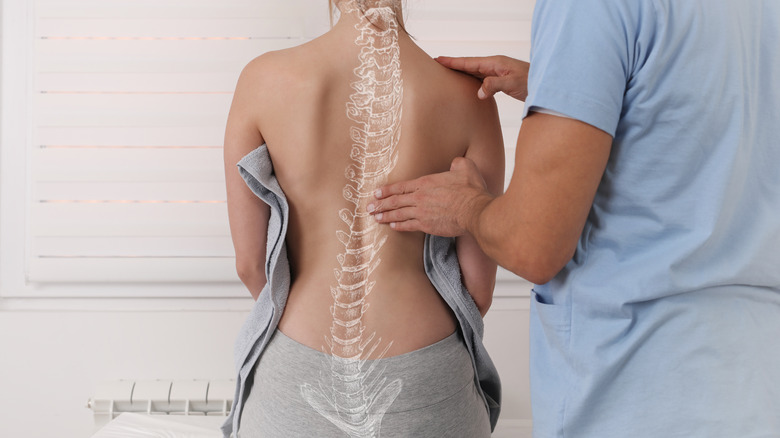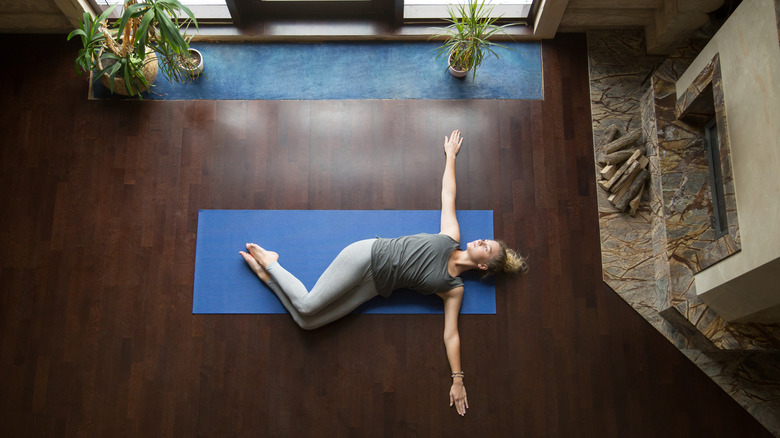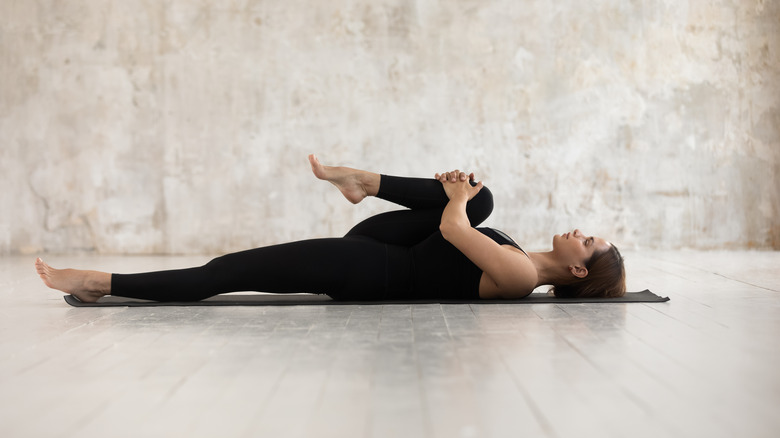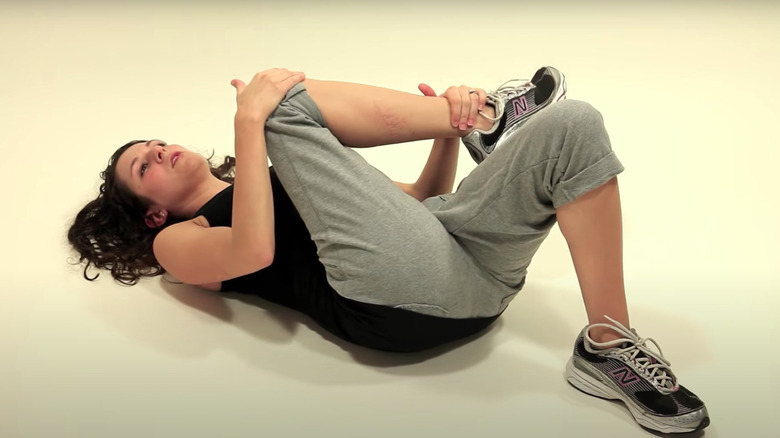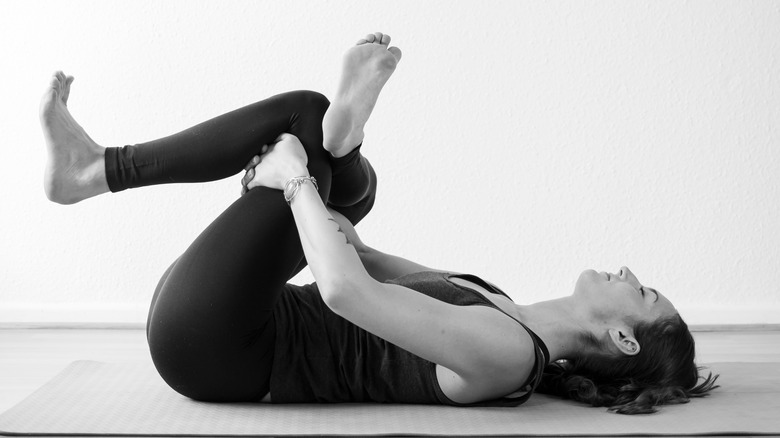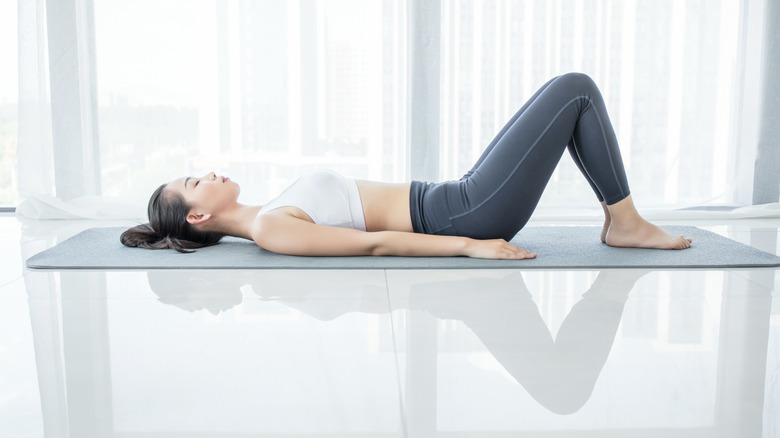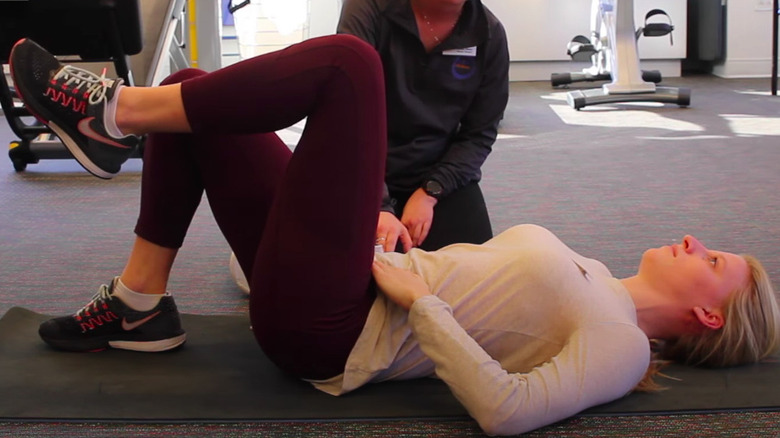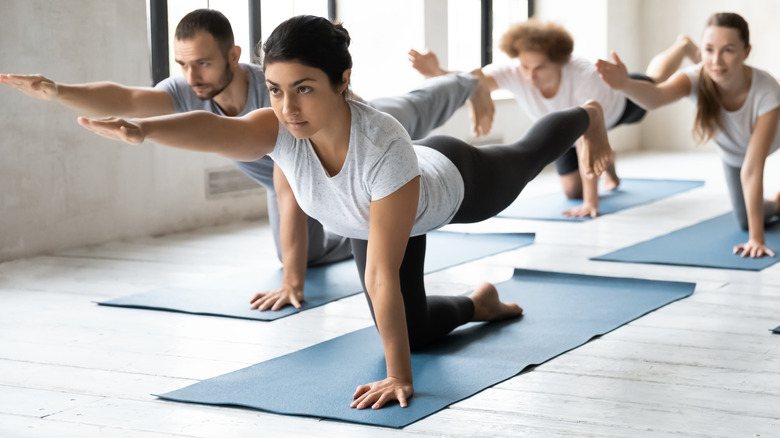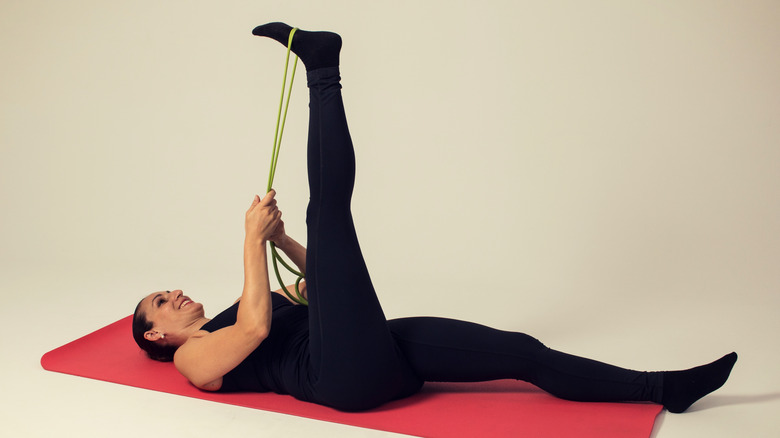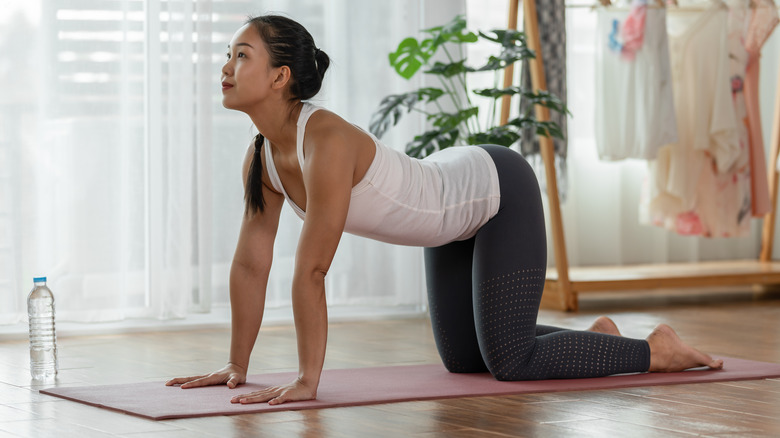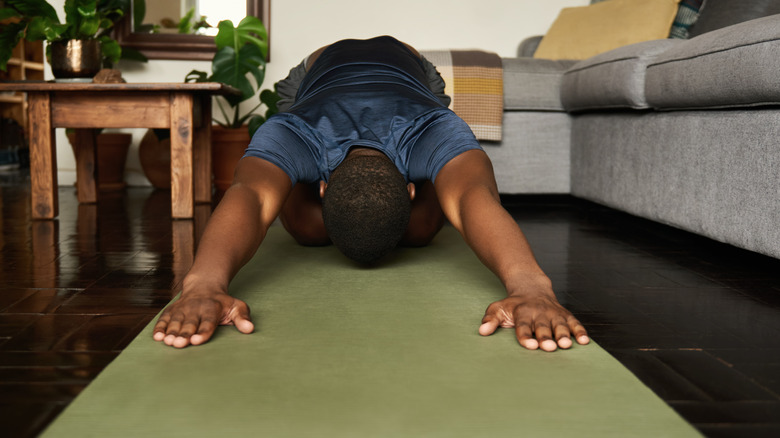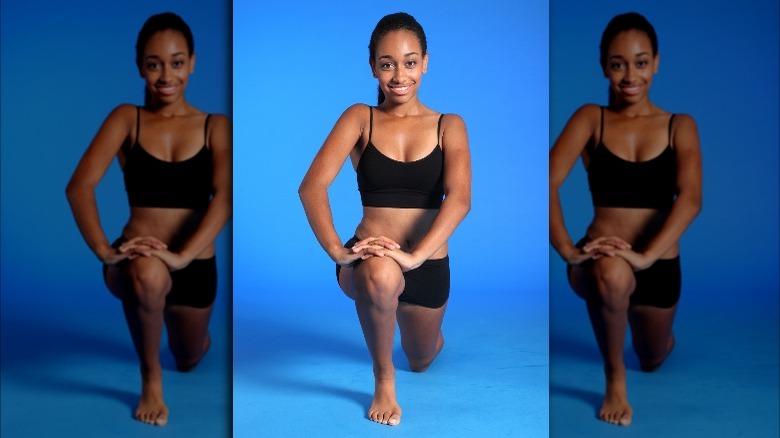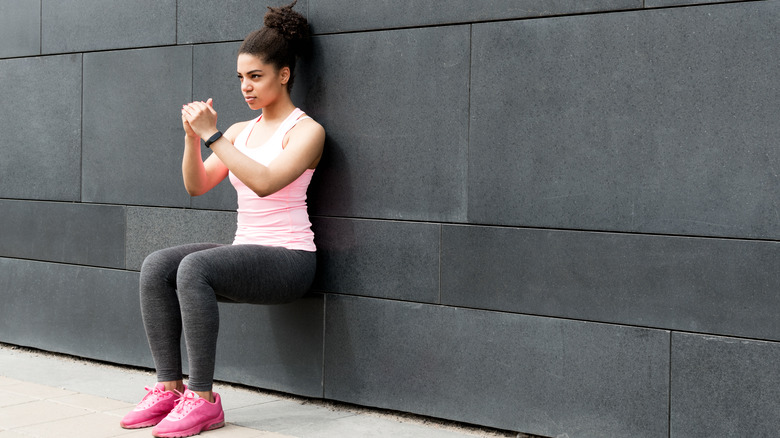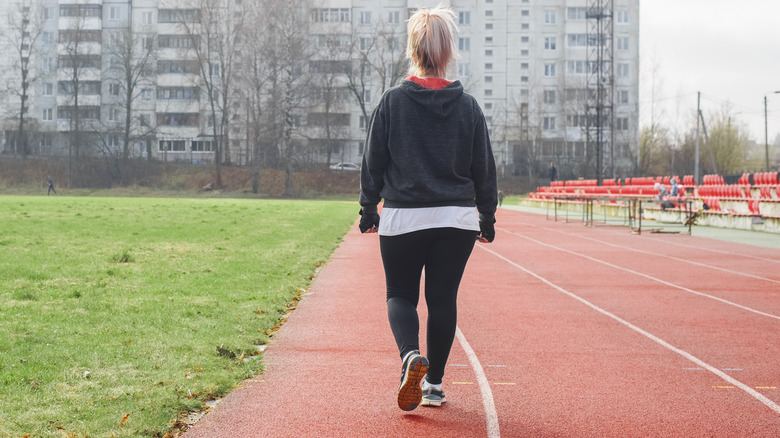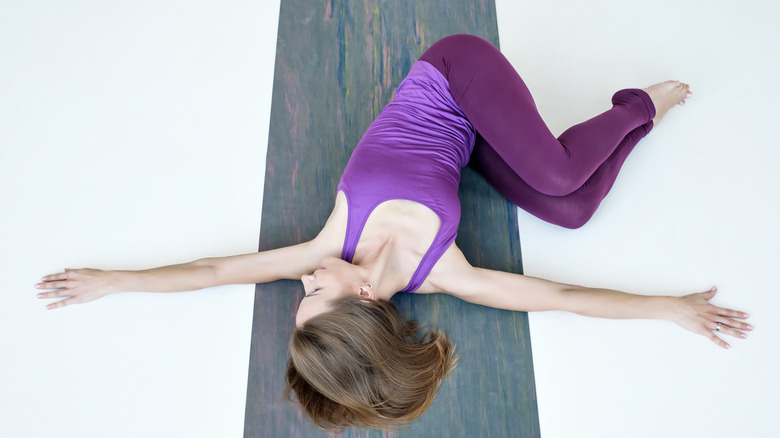Exercises You Should Be Doing If You Have Back Pain
Back pain is incredibly common. In fact, around 80% of people will experience lower back pain at some point in their life (via Healthline). Many physical therapy patients find themselves there due to back pain and subsequent complications.
Your body is made up of a complex web of bones, muscles, tendons, and ligaments. Many of these structures support the spine and overall posture. If muscles or ligaments tighten or become weak, pain is often to follow due to postural compensation. A few key muscles can have a detrimental effect on your overall wellbeing if left unattended and uncared for.
If you are living with chronic back pain, know that you are not alone. We scoured the internet and interviewed experts to find out the best ways to lessen and even prevent back pain. Although physical therapist Emily Burgholzer explained that back pain is best treated on a case-by-case basis, there are some movements that may help at large. From mellow stretches to mild forms of exercise, the following movements may just help relieve your back pain.
Knee rolls
Knee rolls are a great place to start when it comes to relieving back pain. Also known as windshield wipers, knee rolls can be performed from our favorite position: the ol' supine position (via ShareCare). You will begin on your back with knees bent, gently rock your knees from side to side. Of course, you will perform this movement and all others within your comfortable range of motion, according to the Mayo Clinic. It is important to move slowly and with intention so you can truly keep tabs on what your body is feeling.
By rocking your knees in this way, you can stimulate the production of joint fluid in the bones of your back, Jessica Jones, a licensed physical therapist and owner of Emerald Bay Physical Therapy, told Health Digest. An increased amount of synovial fluid, or joint fluid, can help provide cushion for your joints. More joint fluid means more lubrication and less joint friction. Both of these things can equate to fewer back pains and problems in your future (via Healthline).
Knee-to-chest stretch
The knee-to-chest stretch is a classic exercise for relieving back pain caused by facet joint syndrome, physical therapist Emily Burgholzer confirmed to Health Digest. You'll begin on your back and then gently pull one knee towards your chest (via Mayo Clinic). By relaxing in this position, you will increase flexibility throughout the muscles in the lower back, detailed Verywell Health. Physical therapist Jessica Jones recommends holding each stretch for a minimum of 30 seconds two times per day.
Aside from increased lower back flexibility, which can decrease pain caused by tension, the knee-to-chest stretch is awesome because of how accessible it is. No matter how flexible you become, you'll be able to reap the benefits of this easy-to-execute stretch (via Mayo Clinic).
Performing the knee-to-chest stretch offers great gains in terms of range of motion. Not only can it aid in increasing your muscular flexibility, but it can provide helpful joint mobility, too. The knee-to-chest stretch is also effective enough to help decrease the stiffness associated with spinal stenosis and arthritis (via Verywell Health).
Piriformis stretch
As exercise science nerds, we must declare that the piriformis is one of our favorite muscles of all time. The piriformis sits deep within the glute area and is a small, horizontally-oriented, "pyramid-shaped" muscle, Healthline explained. Since the piriformis sits so close to the hip joint and sciatic nerve bundles, if it gets tight and is left unattended, it can cause sciatic pain (via WebMD). Sciatic pain comes from pressure, compression, or tension surrounding the sciatic nerve, a large nerve that runs the length of each leg. Oftentimes, spasms within the piriformis muscle are to blame for this pain.
Lucky for us, the piriformis muscle is fairly easy to stretch once you know how to access it. To begin, lie on your back and hug one knee into your chest. Gently draw your knee towards the opposite shoulder, ensuring that you keep your lower back flat to prevent twisting the spine. As you guide your knee towards your opposite shoulder, you should start to feel a stretch sensation in the glute/mid-butt area. If the sensation is pretty mild, you can try another variation. For this variation, you'll cross your legs tightly. You'll hug both legs as a bundle in toward your chest and slightly toward the shoulder opposite the side you are trying to stretch. Once you find the sweet spot, hold for a minimum of 30 seconds for maximal benefits, physical therapist Jessica Jones advised when speaking to Health Digest.
Glute stretch
In the world of yoga, this stretch is called "reclined pigeon pose." In the world of physical therapy, it is called a glute stretch (via Healthline). Your backside is made up of a large conglomerate of muscles that help propel you through day-to-day life. The three most well-known ones all share the same first name: gluteus maximus, gluteus medius, and gluteus minimus (via Physiopedia). However, there are many more muscles that aid in mobility and strength.
To stretch your glutes, begin by lying on your back. You'll cross one ankle to the opposite knee and gently draw your legs into your chest. Many people find it most comfortable to hold onto the hamstring of the opposite side (not the side you're trying to stretch). It is important to keep the stretching leg's foot slightly flexed to maintain integrity and health in the knee joint (via Healthline). If you are naturally flexible and do not feel a stretch in the meaty part of your bottom in this position, you can gently tug your legs toward the opposite shoulder to ignite a more fiery sensation. Physical therapist Jessica Jones cautioned against seeking out too much sensation, though. She explained that moving into stretches with a gentle approach and deepening them as your body allows will offer maximal bang for your buck.
Abdominal bracing
Behind every person with exceptional posture is a strong core. According to physical therapist Emily Burgholzer, strengthening the core is one of the most important things you can do to alleviate back pain. However, she cautions people with back pain to skip the crunches, as they could lead to compression issues.
Abdominal bracing is a therapeutic way to strengthen the muscles surrounding the center of your body. By strengthening your postural muscles, you can create a natural back brace to support your spine, which can help prevent it from moving in ways that can cause injury (via Healthline). It is crucial to maintain strength and a neutral spine for the overall health of your spine as you age and move, according to Burgholzer.
To perform abdominal bracing, you'll begin lying on your back with your knees bent. You should then inhale to expand your ribcage, then you will essentially flex the muscles of your core as if you are about to take a hit to your stomach. It helps to visualize drawing your belly button back to your spine. You'll continue to breathe while maintaining the contraction. Once your body is accustomed to holding this contraction, you can progress to performing bracing while performing daily activities (via Healthline).
Abdominal bracing with marching
Adding marching to abdominal bracing is phase two. Once you have learned how to maintain a strong, neutral core, it is advisable to start incorporating movements with your legs and arms. This is done to train your body to move through daily life with a strong core (via WebMD).
While this movement can be successfully executed while standing, it is easiest to get a feel for it while lying down. So to begin, you'll lie on your back and start abdominal bracing. Moving with intentionality and breath, you will lift one knee towards the sky, replace it, and then lift the other. You will alternate legs and continue with supine marching. The key component to this exercise is the abdominal brace — you likely will not reap the benefits of this exercise if your bracing is not dialed in. It is advisable to start slowly to build strength and level up from there, according to physical therapist Jessica Jones.
Bird dogs
We aren't dog experts, so we cannot speak to the name of this exercise, but we know it to be a good one for postural support and stability (via Healthline). To perform bird dogs, you'll begin on your hands and knees. It is best to keep your wrists aligned beneath your shoulders and your knees aligned beneath your hips. You will want to find the middle ground between arching and rounding your back — this will essentially be your "neutral spine" position, according to Healthline.
Keeping your hips level, you will extend one leg behind you, keeping your heel at hip height or lower. You will then repeat the same movement on the other side, staying intentional and focused in your movements. You can then extend an arm to challenge your balance and further build strength. If you extend your right leg behind you, you'll extend your left arm forward, continuing to keep your hips level and maintain a neutral spine. Alternate sides and keep focusing on how level you can keep your hips (via Healthline).
Hamstring stretch
The hamstring group is a very important yet often underestimated group of muscles that exist on the back of the upper leg. Loosening the hamstring group can often lead to better mobility throughout the hips and lower back area. Much like the gluteus and piriformis stretches, elongating the hamstrings can decrease tension that may be creating pain in the low back, physical therapist Jessica Jones told Health Digest.
A supine hamstring stretch is a fairly accessible stretch that has huge benefits. As you may have guessed, you get to start by lying on your back. You will loop a yoga strap, a towel, or a piece of clothing around the ball of the foot you want to stretch. Keeping both legs straight, you'll extend your stretching leg up towards the sky, keeping a bit of focus on your foot. To maximize the stretch sensation, draw your toes back towards your face, aka ankle flexion, according to Jones. Relax and take some deep breaths in this position to further enjoy the benefits. WebMD recommends holding this stretch for a minimum of 30 seconds, two to four times per leg.
Cat cows
Cat cows are crucial when it comes to flexibility and mobility of the spine. Regularly performing cat cows can help loosen tension throughout the entire spinal column, shoulders, and neck. By taking each joint in your spine through its full range of motion, you will be better able to move freely and without pain (via Healthline).
To enjoy all of these benefits, begin on your hands and knees in a neutral spine. You will inhale, drop your belly down towards the ground, lift your eyes to the sky, and pull your chest as far forward as you can. You can use the inhale to expand the lungs and find further openness through your chest. On your exhale, draw your belly button up and in and press the back of your heart to the sky. You'll then drop your chin towards your chest to look towards your stomach — this ensures that the mobility work targets each and every vertebra, according to physical therapist Jessica Jones.
Following the rhythm of your breath, you can move through as many cat cows as you'd like. It is important to stay within your comfortable range of motion as you move. And as always, stay intentional about your movements to maintain spinal safety and gain the most mobility for your effort, advised Jones.
Child's pose
Child's pose is a quintessential yoga pose that can provide many great benefits when performed regularly. It is yet another therapeutic stretch that allows tension through the spinal muscles, neck, shoulders, and hips to dissipate (via Healthline).
You can find your way into child's pose by starting on your hands and knees. You will bring your feet together behind you and gently send your hips back towards your heels. If it is uncomfortable to get your knees into such deep flexion, you can roll up a towel and place it behind your knees, advised Healthline. Once you get your lower body configured, you'll start to sink your chest forward to the ground in front of you and extend your arms forward. As always, it is important to keep awareness of your body's feedback, and if something starts to hurt or pinch, back out of the pose. Once you find your comfortable space in this shape, it is important to breathe and relax to allow your muscle fibers to elongate, according to physical therapist Jessica Jones. The Healthline experts further recommend holding this pose for about one minute as many times as you'd like.
Hip flexor stretch
Your hip flexors live on the front side of your body. Aptly named, your hip flexors are the muscles that can execute flexion of the hip joint — this is also known as marching or lifting your knee toward your torso. Your hip flexors are the muscular link between your upper and lower body, physical therapist Jessica Jones told Health Digest.
In the Western world, in particular, we do a lot of sitting (per Forbes). And in a seated position, your hip flexors get crumpled up and often neglected. A build-up on tension throughout the hip flexors can wreak havoc on the health of your lower back, Jones detailed. To add insult to injury, running can actually cause more tension through the hip flexors. The best way to rectify this and achieve balance is by stretching your hip flexors (via MedicineNet).
To effectively stretch the hip flexor muscle group, you'll begin by kneeling down on one knee. Draw your belly button in towards your spine to ensure integrity through your lower back. The benefits of this stretch can easily be undone by arching the back and creating further compression, according to Jones. Gently press your torso forward to deepen the angle of the front knee. You may start to feel a stretch here; if not, emphasize a lift through your chest. By lifting your heart to the sky and sinking slightly forward, you should be able to light up a soft stretch sensation through the front side of the back leg (via Healthline).
Wall sits
Wall sits are a precursor to squats, which can be employed in many different ways to build strength. Wall sits are great because they are an isometric activity. Isometric movements are those that create muscular contraction without action or moving joints through their ranges of motion, physical therapist Emily Burgholzer explained to Health Digest. A major benefit of isometric exercises is that since you do not have to move joints to execute them, you can focus your attention on maintaining a neutral and strong spine, physical therapist Jessica Jones added.
To perform a wall sit, you will stand against a wall and sink down until your knees are bent at a comfortable yet challenging angle. Step your feet forward enough to keep your heels down (via WebMD). In fact, this exercise is most effective if you press your weight into your heels. To maintain the integrity of the knees, it is important to avoid performing wall sits and squats with weight pressing on the toe sides of your feet. You will hold this until you start to feel a build-up of lactic acid (i.e., "the burn"), which is dependent on your level of conditioning, according to Jones.
Walking
Walking and other aerobic exercises are great for helping to rectify some causes of back pain (WebMD). Consistent light aerobic activities can help you lose weight, which lightens the load your skeleton has to carry. This often helps relieve joint pain that was caused by carrying extra weight on your frame, according to physical therapist Jessica Jones. Regular movement can help lubricate the joints and increase flexibility too. Both of those things can aid in an overall feeling of physical health and wellness, Jones continued.
Unlike many specified exercises to strengthen the core and stretch problematic muscle groups, walking and aerobic exercise may not target the causes of some types of back pain. However, experts agree that consistent movement is one of the best things you can do for your body (via Mayo Clinic). Additionally, weight-bearing exercises can help decrease the risk of developing osteoporosis, which can leave your bones at risk of fracture, according to the Mayo Clinic.
Spinal twists
Spinal twists tend to polarize the therapeutic fitness community. On the one hand, they can relieve tension, organize the bones of the back, and offer some pain relief. On the other hand, improperly executed spinal twists can cause sacral instability and disc herniation, according to Verywell Health. A good rule of thumb for enjoying a spinal twist is to do it with intention and focus on the sensations you are feeling, physical therapist Jessica Jones advised. If it doesn't feel good, don't do it!
A gentle supine twist is a great option for testing the waters. To try this out, Jones recommends lying on your back with your knees bent. Then you will allow your knees to fall to one side and turn your head and neck to face the other. Once you find what feels comfortable, you can relax and breathe into that shape to allow your muscle fibers to soften, according to Jones. A supine twist will stretch the muscles surrounding your spinal column, which could lead to better posture and a more comfortable back (via Verywell Health).

